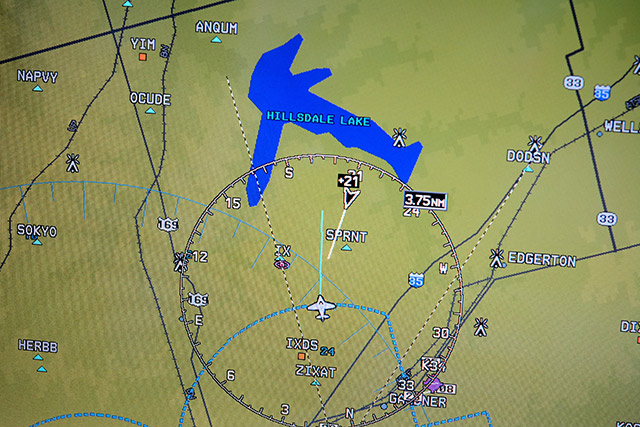
Garmin’s new GTX 345R remote-mount transponder allows the display of ADS-B traffic on this Diamond DA40’s G1000 multifunction display.
Hardware also a boon to older G1000 panels
Garmin International has added a line of all-in-one ADS-B transponders to its suite of Automatic Dependent Surveillance-Broadcast products. The GTX 345 is a 1090ES Mode S transponder that provides ADS-B Out compliance; it also receives weather information on the 978 MHz Universal Access Transceiver frequency, and traffic information on both ADS-B datalink frequencies. The GTX 335 provides ADS-B Out only. An integral WAAS GPS receiver that meets the ADS-B Out position source requirements is available as an option for both transponders.
The GTX 345 mounts in the radio stack.
“We’ve known for a few years that this dual-band product is where we wanted to go with the technology,” said Phil Straub, Garmin vice president and managing director for aviation. “This product has really been designed to serve the broad range,” from early G1000 panels without Wide Area Augmentation System GPS to the company’s current product line. It will provide an ADS-B solution for many integrated flight decks, he added. “Where manufacturers are integrating it, [data] will be displayed in an optimum fashion.”
ADS-B, which uses satellites instead of ground-based radar to determine aircraft location, is a key technology behind the FAA’s Next Generation Air Transportation System. The FAA has mandated ADS-B Out equipage beginning January 1, 2020, for operations in most airspace where a transponder is required today.
As of February 1, 16,765 U.S. general aviation aircraft were equipped for ADS-B Out, according to the FAA, which estimates GA equipage at 10.5 percent to 16.8 percent of the fleet. During January 2016, 709 GA aircraft equipped with the technology.
Garmin’s GTX 345 can display ADS-B traffic and weather on a variety of current and legacy Garmin displays. Built-in Bluetooth capabilities allow traffic and weather data to be shared wirelessly with tablets running the Garmin Pilot or ForeFlight Mobile apps. Both the GTX 345 and 335 are available in remote-mount configurations, where they can be controlled by a Garmin G1000 or GTN 650/750.
The new transponders’ size and form factor should make them an easy replacement for most popular transponders, including the Garmin GTX 327. The panel-mount unit is 1.65 inches tall and has a bright, sunlight-readable digital display that includes pressure altitude readout. It’s 1.25 inches longer than a GTX 327.
“We did intentionally stay with that vertical height, knowing there are a lot of people out there with that transponder size limitation,” Straub said. A timer is built in.
Garmin said the GTX 345/335 will provide select G1000-equipped aircraft, with or without WAAS capability, with an elegantly simple path for ADS-B compliance. In a non-WAAS G1000, for example, the GTX 345’s optional WAAS GPS receiver provides the required ADS-B position source. In such a scenario, the aircraft’s navigation systems do not receive the WAAS location information and no new IFR navigation capabilities are provided.
Indeed, on a February demonstration flight in Garmin’s G1000-equipped 2002 Diamond DA40, the remote-mount GTX 345’s transponder and ADS-B In functions were easily controlled using intuitive menus accessed through push buttons on the G1000’s primary and multifunction displays. Although we were flying in clear skies, Flight Information Services-Broadcast, ADS-B’s subscription-free weather service, showed a strong winter storm approaching the Kansas City area from the northwest.
The ADS-B traffic system proved its worth on our approach to New Century AirCenter’s Runway 4 in Olathe, Kansas. The extended runway centerline passes very near Gardner Airport, and it was there that a traffic symbol appeared on the MFD, its altitude indicating the aircraft was only 300 feet below us. Soon thereafter, the tower controller called out the traffic to us, and a few seconds after that, the pilot called the tower, “Off Gardner, landing Olathe.”
Garmin on several occasions has indicated its desire to display ADS-B In data on even the oldest G1000 systems, and this hardware goes a long way toward making that happen. A chart detailing compatibility with various G1000 installations can be found on the Garmin website. Some G1000 installations will require software updates through the airframe manufacturer in order to display ADS-B traffic and FIS-B weather.
On aircraft equipped with the required software version, pilots may view subscription-free weather—including Nexrad radar, METARs, and TAFs—on the MFD. For aircraft equipped with synthetic vision technology, ADS-B traffic targets can be displayed on both the MFD and primary flight display. Connext hardware will allow ADS-B In data to be wirelessly streamed to portable Garmin GPSes like the aera 796/795, as well as to devices running the popular Garmin Pilot and ForeFlight Mobile apps.
In addition to G1000, the GTX 345 integrates with many other installed displays to depict ADS-B In data, including the GTN 650/750 touchscreen series, the GNS 430W/530W GPS/nav/com navigators, and other third-party displays.
Support for the G500/G600 is expected in the second quarter of 2016, and compatibility with the G3X Touch glass flight display is expected in the third quarter.
When used with compatible displays, the GTX 345 incorporates Garmin’s exclusive TargetTrend and TerminalTraffic enhanced traffic display features. If integrated into the aircraft’s audio panel, it will provide ATC-like audible alerts, such as “Traffic: 10 o’clock, same altitude, two miles,” to help pilots keep their eyes outside the cockpit. An optional altitude encoder mounts on the transponder tray for easy installation and service.
The GTX 345 and GTX 335 have received FAA technical standard order authorization, and Garmin expected supplemental type certificate approval and to be shipping both new transponders by the end of February. The company expects European Aviation Safety Agency (EASA) validation later this year.
The GTX 345 ADS-B Out and In transponder has a list price of $5,795 with the optional WAAS GPS receiver, and $4,995 without it. The ADS-B Out-only GTX 335 lists for $3,795 with the WAAS GPS and $2,995 without. Remote-mount versions are priced the same as the panel-mount transponders. More information is available online.
Email [email protected]
Web: See AOPA’s online ADS-B resources and ADS-B selection tool .
A standout ADS-B receiver
Solar panels extend battery life
By Dave Hirschman

It’s hard to stand out in the ultra-competitive ADS-B receiver market, but iLevil’s 2SW pulls off this feat with some very clever innovations.
Solar panels built into each unit extend battery life up to six hours in bright sunshine, a big plus for the notoriously power-hungry units. Dual channels (both 978 UAT and 1090ES) can provide a full traffic (for ADS-B-Out-equipped aircraft) and weather picture. And an exceptionally high-quality AHRS inside provides high-fidelity pitch, roll, and yaw information, as well as groundspeed and track.
The iLevil 2SW is the latest and most capable ADS-B receiver produced by Levil Technology, a Florida firm founded by Ruben D. Leon and managed by his daughter Ananda, a software engineer. The family’s personal history of fleeing persecution in their native Venezuela, starting a business from scratch in their adopted country, and making it a success is a twenty-first-century Horatio Alger Jr. tale. The company was one of the first to recognize the cockpit clout of the iPad in 2010, and it has been developing iOS and later Android products ever since.

Setting up the iLevil 2SW is a simple matter of charging the battery and attaching the external antenna. The company has a free AHRS app, which I installed on both an iPhone and iPad. Then it was time to go flying.
The iLevil 2SW is about the size of a pack of cigarettes, and I mounted it so that the built-in solar panels had a direct view of the sky. The internal Wi-Fi quickly established wireless connections to my iPhone and iPad, and the company claims it can simultaneously link 10 devices.
The iLevil app shows a primary flight display with tremendous sensitivity and fidelity. Using it to maintain aircraft control in instrument conditions, or even shoot an IFR approach, would be well within its capabilities.
The iLevil 2SW plays well with a wide variety of electronic flight bag apps, including Wing X Pro7, FlyQ, and Xavion—basically everything except market leaders ForeFlight and Garmin Pilot. It’s a shame the iLevil 2SW is locked out of those popular products, because its longer battery life and other features could make them even better.
In the air, the iLevil 2SW allows the aviation apps it supports to perform to their full potential. Traffic, weather, terrain, obstacles, and synthetic vision provide the kind of situational awareness that have made iPads so ubiquitous in today’s cockpits. The amount of timely information it provides is nothing short of astonishing.
Price: $1,045
Web: www.levil.com
Plus: Solar panels extend battery life. Dual channel and 3-axis AHRS.
Minus: Doesn’t play with ForeFlight or Garmin Pilot.
Email [email protected]
Do-it-yourself ADS-B In
Weather and traffic for $120
By Dave Hirschman
As a general aviation pilot, Chris Young saw tremendous value in the Automatic Dependent Surveillance-Broadcast (ADS-B) system’s free in-cockpit weather and traffic. But as an engineer, he couldn’t understand why ADS-B receivers cost as much as they do. (Retail prices typically range from $500 to $1,000.)
So he decided to build his own ADS-B receiver to satisfy his curiosity.
“I thought it would be sort of a fun project,” said Young, 29, a Michigan-based private pilot who recently purchased his first airplane, a Piper Warrior. “It only took two or three days to get the first version working.”
Young called his creation “Stratux,” a play on the names Stratus and Linux, the open-source software that drives it. Young published a how-to manual on Reddit for others who wanted to build their own ADS-B receivers for about $120. The response has been so enthusiastic that web superstore Amazon now sells a Stratux kit so that buyers can get all the required hardware with one mouse click.
Young has modified Stratux so that it can show dual-band traffic and weather on a variety of aviation apps, including ForeFlight.
Frank Noe, a GA pilot at AOPA’s home field in Frederick, Maryland, assembled a Stratux and we linked it to an iPad running ForeFlight. It worked exactly like brand-name ADS-B receivers. Except for the lack of an internal AHRS, there was no discernable difference in the information it provided, compared to the high-end receivers made by well-known avionics manufacturers.
I’ve been reluctant to write about Stratux, however, because of intellectual property concerns. Is Stratux pirating software without compensating the developers? Is it violating patents, or profiting from others’ inventions? Young says he’s using open-source software for its intended purpose—and he wrote his own computer code based on the FAA’s published ADS-B guidance.
“I hit the [FAA] specs and wrote the software myself,” he said. “Just because it’s free doesn’t mean it’s pirated.”
Young said he has no financial stake in Stratux sales. He gets nothing from hardware purchases, and he allows others to download his software without charge. To Young, this is simply one pilot helping others get access to vital safety information that helps them to avoid other aircraft and adverse weather.
“I fly for fun,” he said. “I wanted a low-cost ADS-B receiver. I made it, and now I’m sharing it.”
Step-by-step Stratux build instructions are available on a website Young created for users. Several YouTube videos document the entire process, too, so I won’t repeat that information here.
As with other ADS-B devices, the Stratux receiver only shows a full traffic picture to aircraft emitting ADS-B Out signals. And finding a low-cost way of providing ADS-B Out could be Young’s next area of aviation inquiry.
“Stratux is the only engineering project I’ve worked on in aviation,” said Young, a 2008 University of Michigan engineering grad, who is an engineering consultant on projects in a variety of industries. “Pilots are looking for less expensive ways to comply with [the 2020 ADS-B Out mandate]. And I definitely think something can be done about that.”
Email dave[email protected]




